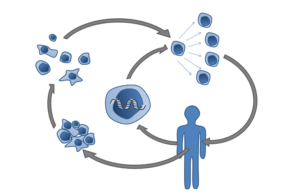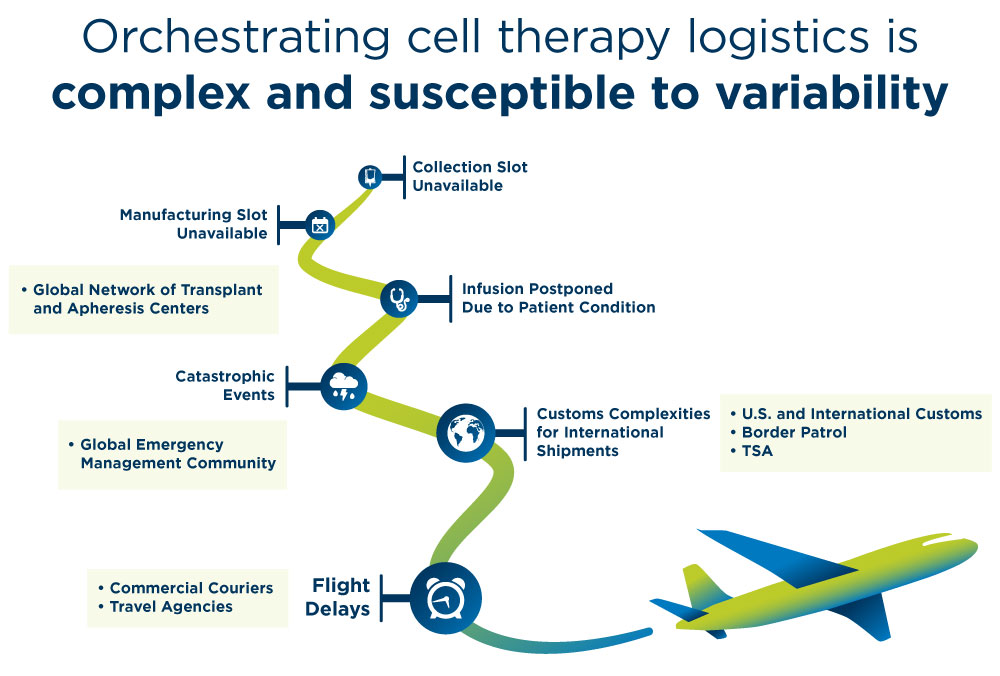
Cell therapy image from Wikimedia Commons
The cell and gene therapy market continues to advance, thanks to its promise to treat cancers and other severe diseases. While the pandemic has had a negative impact on companies specializing in cell and gene therapies, it has also catalyzed interest in cold-chain logistics while also highlighting the promise of new therapy types.
Organizations interested in expanding their focus on cell and gene therapies can learn from best practices from organizations specializing in high-stake logistics.
Push for standards and collaboration
The initial focus on transporting mRNA vaccines at below-normal temperatures “highlighted the need for some sort of standardization,” said Ray Hornung, senior manager, logistics and emergency preparedness at Be The Match BioTherapies (Minneapolis).

Ray Hornung
While the International Organization for Standardization (ISO) has provided information that serves as a “great starting point,” organizations involved in shipping cell and gene therapy products must collaborate with partners on best practices.
Be The Match Biotherapies has built partnerships, working with software companies and major pharmaceutical clients. “We’ve developed partnerships with manufacturers such as Lonza so that when a client comes to us, we can provide a much more complete package,” Hornung said.
Such partnerships have enabled Be The Match to offer a standard process optimized for speed. “We can say, ‘Here’s our standard process. If you want to get your trial started as soon as possible, then accept this process to support your study,’” Hornung said. Conversely, clients that need more specialization could encounter more process development time. “Whether it’s an autologous patient or allogeneic donor, we can provide you what you need in a much more streamlined fashion if you take the standard menu.”
Learn from organ transplantation logistics
Problematic organ deliveries played a role in the genesis of the logistics firm Airspace.
“We specialize in timing-critical freight forwarding. Think of it like the four-minute mile of logistics,” said Ryan Rusnak, the company’s CTO and co-founder.
 The company’s other co-founder and CEO, Nicholas Bulcao, had witnessed a string of problems freight forwarders encountered when attempting to ship organs. “He saw these freight forwarders picking up the wrong packages, misrouting them, mis-dispatching them,” Rusnak said.
The company’s other co-founder and CEO, Nicholas Bulcao, had witnessed a string of problems freight forwarders encountered when attempting to ship organs. “He saw these freight forwarders picking up the wrong packages, misrouting them, mis-dispatching them,” Rusnak said.
While Airspace works with various client types, including organizations shipping cell and gene therapies, organ transplant logistics is unique in its ability to capture the need for time-critical delivery. “When you’re shipping an organ for transplant, if you save 10 minutes or an hour, you might be adding years onto someone’s life,” Rusnak said. “Donated organs become less viable for the recipient as time goes on.”
Organizations that require time-critical and temperature-sensitive logistics can learn from this experience. “Shipping an organ is similar to shipping a vaccine or shipping something for gene therapy,” Rusnak said.
Don’t underestimate supply chain complexity
As simple as it may seem conceptually to deliver a product from point A to point B, delivering potentially life-saving cell and gene therapies to patients can be difficult for humans to comprehend.
Stem cell products, for instance, have a short life cycle when they are fresh. And transportation can represent one of the biggest threats to them.

Image courtesy of Be The Match BioTherapies
Shipping such materials thousands of times per year provides ample experience for Be The Match to witness that the core bottleneck was cell transportation rather than cell sourcing or cell collection. “Almost all of our excursions occurred during transportation,” Hornung said. “So I have focused my efforts over the last five years on making sure that we get the stuff where it needs to go in the condition that is expected to be in and the time that they expect it to arrive.”
The logistics involved are fundamentally more challenging than, say, ride-sharing. “An Uber driver doesn’t have to go through security and execute a very complicated procedure,” Rusnak said.
Rusnak said that there are a quadrillion different possible flight paths to choose from when shipping a package between San Francisco to Hamburg, Germany. Making sense of such data sets requires artificial intelligence, Rusnak said.
Flight paths or ground transportation options represent a single dimension of logistics. There are also geofence updates, frequent communications, GPS timestamps and geotags to consider.
“The more I learned about the problem, the more I realized this problem is so computationally difficult,” Rusnak said.
“If you think about what’s going to trigger a geofence update, you need lots and lots of constant communication from the field to make that happen. So you can see these are actually telemetry points, GPS timestamps and geotags.” Rusnak explained.
There is also, for example, the need for specific cell- and gene therapies. “Because we have 32 million people we can tap into worldwide, we are well placed to help our clients find the exact characteristics that they require from those donors, for them to do their manufacturing and to implement their studies,” Hornung said.
Be The Match also has a robust donor contact team with an internal network of apheresis research centers. “We can do those collections and then seamlessly move that into our own transportation and then into our partners’ hands for manufacturing,” Hornung said.
Make use of smart logistics when feasible
The concept of smart logistics has a long history conceptually, but IoT technology is finding growing use in logistics.
Hornung said smart sensors are especially useful in dry shippers. “With dry shippers, I don’t have an advocate there hand-carrying that cooler,” he said. Be The Match thus uses dry shippers with smart caps. The electronic sensors in the caps monitor and record internal temperature, external temperature, tilt, humidity and shock if the shipper is dropped or knocked over. If the sensor detects a condition outside of ideal values, Be the Match gets an alert enabling the company to reach out to vendors to correct that situation. In the past, passive monitoring made it impossible to know if a problem arose until the shipment arrived at its destination. “If something happens to it, even before it gets delivered to the site, then we know that we need to cancel that order and get a new dry shipper on the way,” Hornung said.
Organizations looking to deploy smart logistics technologies don’t need to go it alone. “For instance, there are different providers that manage the software and manage the inventory of those smart dry shippers,” Hornung said. Be The Match works with companies that manage data collection from such smart devices and send relevant information over a cellular network. “We have public URLs where we can monitor [these data] to see exactly what the condition is,” Hornung said. “And we share that transparency with our clients with our partner manufacturers so that everyone knows the condition of the product and where it is.